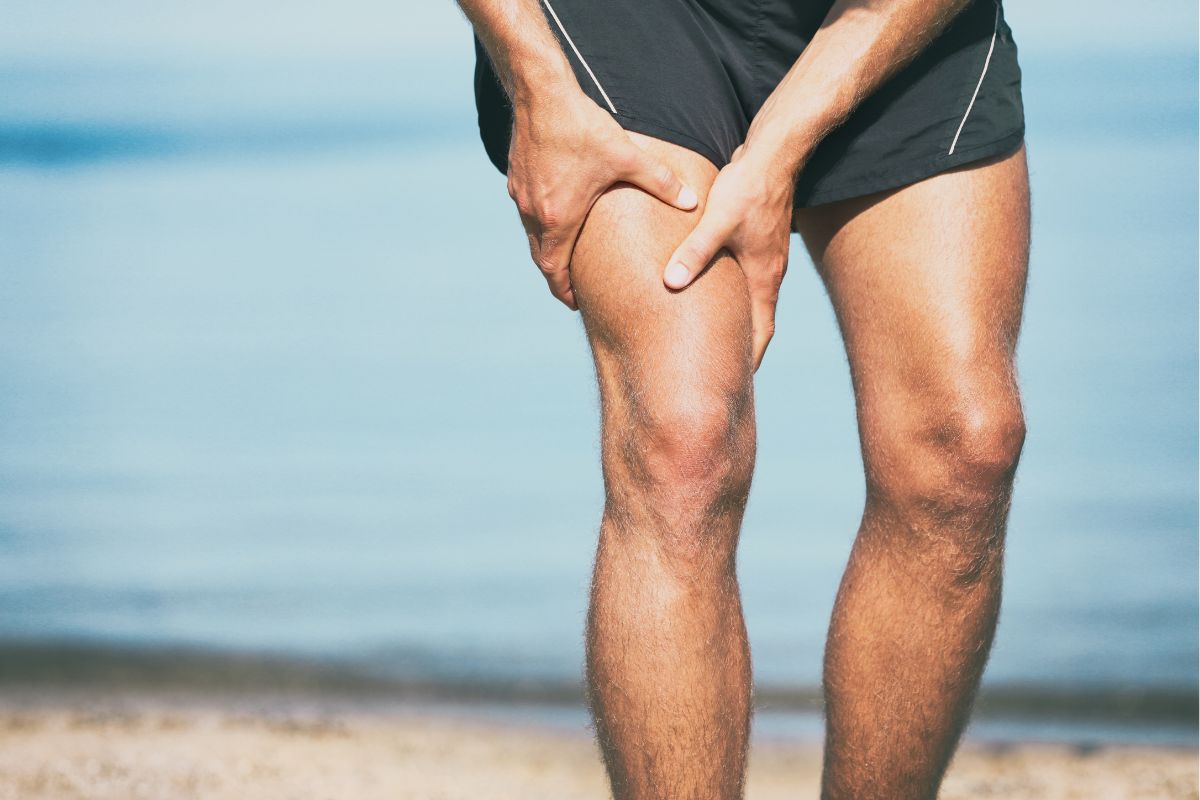For runners who have recently been focusing on hill runs or fast interval training, quad pain may start to develop.
When running, almost half of the force need to run is provided by the quads and so it makes perfect sense why they can get sore every once in a while.

Knowing why the quads become sore and how to soothe and fix this pain will help you to treat quad pain while also working to prevent it from reoccurring in the future.
Why Quads Become Sore After Running
The quadriceps are built from four muscles that are often viewed as one system.
Healthy quads are important for runners as the strength and ability of a runner’s quads will have a huge impact on their ability to run.
When quads begin to feel painful this is often our bodies sending a message to show us that a run or training session may have been outside of our comfortable training tolerance.
This is common after a long run where you may have done more miles than usual, gone at a faster pace, or possibly spent more time on hills.
When a muscle is struggling after one of these sessions it sends a message to the brain through the nervous system to alert the brain of these pains and feelings.
How To Soothe Sore Quads
When you are feeling pains in your quads there are several things that you can do to instantly help to soothe them.
The first thing you can do is to take a hot bath with Epsom Salts to help soothe the muscles. After bathing you should also rub Magnesium Cream into the muscles to aid recovery overnight.
Another great way to soothe sore quads is to go partake in some low-intensity aerobic exercise, such as cycling, swimming, walking, or jogging as these activities help to reset the nervous system, helping to soothe the muscles.
How To Fix Sore Quads
Here are some exercises that can be used to rehabilitate any sore quads while also helping to prevent any further quads pains after running.
By spending time after training to complete these exercises you will help your muscles to build their training capacity, which means they will be stronger and you will be less likely to experience pains.
Banded Quad Extensions
To perform a banded quad extension you will need a resistance band and a chair that allows you to place your feet flat on the ground.

Once you have this equipment, follow the steps below:
- Place on end of the resistance band under a leg on the chair before sitting on it. Take the resistance band and place it around the foot that it is closest to.
- Slowly lift the leg until the knee is fully extended and slowly return to the starting position.
- Repeat for 1 minute before swapping to the other side.
This exercise is great as it isolates the quad and works it in a gentle motion. The fact you are sitting also offers more support to the quad.
Lunges
To perform a lunge you can decide whether to use your body weight or use additional weight by holding a dumbbell in each hand while performing the movement.
To lunge you will need to:
- Stand with your feet a hip-width apart
- Step forward on the left leg and bend the left leg until the right knee touches the floor
- Return the left foot to the starting position
- Repeat for 30 seconds before switching to the other side.
We recommend starting this exercise with no weight, especially if your quads are in pain, and slowly building up to adding weights.
Lunges are a great way of stimulating the quads and so this exercise can be sore initially but it will help to strengthen the quads over time.
Split Squats
To perform a split squat you will need a low chair and you can decide whether to use your body weight or use additional weight by holding a dumbbell in each hand while performing the movement.
To perform a split squat:
- Stand in front of a chair, slowly lift one leg behind and place it on the chair, foot facing downwards
- The motion is the same as a lunge, bend the leg not on the chair until the opposite knee reaches close to the ground
- Repeat for 30 seconds and switch to the opposite side.
This is a great exercise for working the quads hard. Adding weight to this exercise will reap great rewards for every aspect of your running training.
Final Thoughts
We hope that you now have more of an understanding as to why you may experience sore quads and also how you can soothe and fix this problem by using our tips and suggestions.
If you are still experiencing pain we recommend seeking professional advice.
- Can Dogs Run Faster Than Humans? (Running With Your Furry Friend) - October 4, 2022
- 10 Doggie Fun Runs You Will Love [Ultimate Guide] - October 4, 2022
- What Are Division Results In Running? - October 4, 2022








